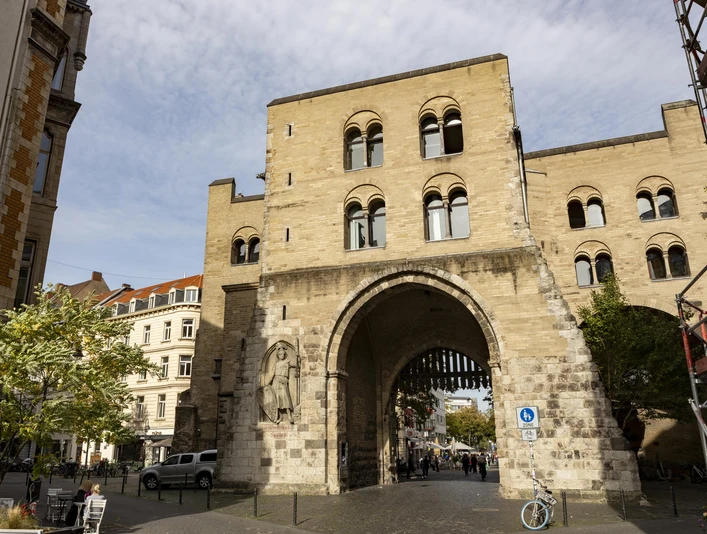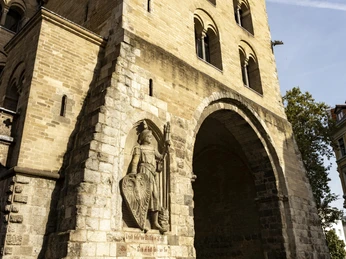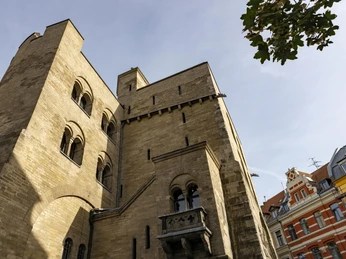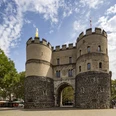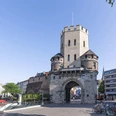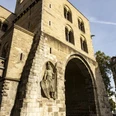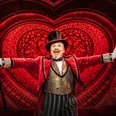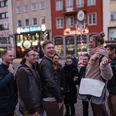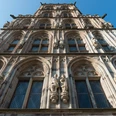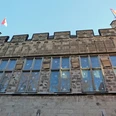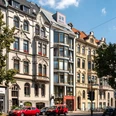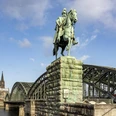Yet, the Eigelstein City Gate is far more than just a memorial site: from afar, it appears as a mighty witness of the medieval city history—and perhaps that's why it is one of the most frequently visited tourist spots in Cologne. As one of four surviving towers of the former twelve gate castles in Cologne's eight-kilometer-long city wall, the Eigelstein City Gate secured and represented Cologne to the north.
The Gate to the Eychelsteynen
The gate castle draws its name from the street that passes beneath it: the Eigelstein. This street has existed since Roman times and led outside the city past cemeteries. These cemeteries often featured stone pinecones on their tombstones—a symbol of immortality, which the people of Cologne referred to as "Eychelsteyne" because they resembled acorns. Thus, "Eychelsteynen" became "Eigelstein."The History of the Gate Castle
The Eigelstein City Gate was built between 1228 and 1248 during the third city expansion. The former Eigelstein Gate, built during the second city expansion in 1106 about 100 meters further south, was later replaced by the new city wall. No remnants of this old gate, presumably located near Eintrachtstraße or "Unter Krahnenbäumen," remain. As a large gate castle, the "current" Eigelstein Gate still connects to the city wall.Through this northern gate, Maria of Medici entered the city on October 12, 1641, after being exiled from Paris by Cardinal Richelieu. Emperor Napoleon, along with Josephine, his wife, also passed through on the evening of September 13, 1804, amidst cannon fire and bell ringing.
From Prison to Museum to Open Jazz House School
In 1882, as with the Severins City Gate, the constructed bastion in front of the Eigelstein City Gate was removed, and restoration began in 1889. The stone figure in the pointed arch niche was placed in 1891 in honor of Emperor Wilhelm II's visit and commemorates, as the "Kölsche Boor," the Battle of Worringen in 1288 and the efforts of the Bergische farmers and the citizens of Cologne to attain Cologne's imperial city freedom against Archbishop Siegfried of Westerburg.Until the end of the 19th century, the Eigelstein City Gate served as a prison for military detainees, then as a museum. World War II inflicted minimal damage; the destroyed parapet walk was restored in 1957, and the equally destroyed roof exit tower was faithfully reconstructed in 1975. The west tower was also restored in the 1980s. Today, the gate castle appears as a three-story double-tower gate. Since 1990 provisionally and officially since 1995, the Open Jazz House School has been based there.
Twelve Gate Castles of Cologne: Protection and Representation
Four of the grand gate castles are still preserved today—besides the Eigelstein City Gate, the Severins City Gate, the Hahnen City Gate, and the Ulrepforte on Sachsenring in the Altstadt-Süd. With the demolition of large parts of the city fortifications in the 19th century, the other eight of the original twelve gate castles were leveled to the ground.These grand city gates shaped Cologne as a major European metropolis, controlling the access of ideas, goods, and cultures, trade, travelers, and pilgrims—as protection, threshold, and representation. The remaining gate castles are situated amid modern Cologne—and are always a historically intriguing starting point for your urban exploration tours. Explore the medieval heritage of Cologne—and connect it with the present, the lively activity of today in a magnificent metropolis.
Good to know
Eligibility
Suitable for any weather
for Groups
for families
for individual guests
Suitable for the Elderly
Payment methods
Directions & Parking facilities
More information
Our recommendations
Nearby
